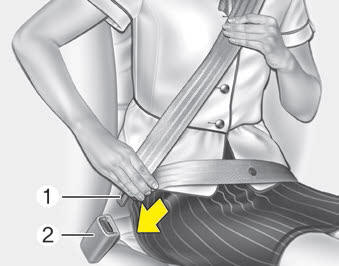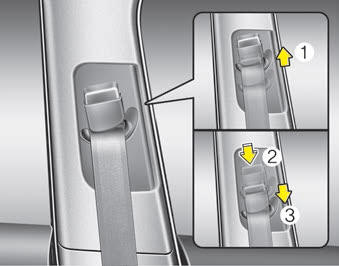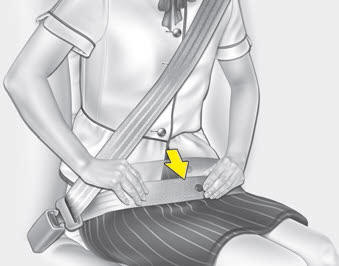 Kia Sportage: Seat belt - Driver's 3-point system with emergency locking retractor
Kia Sportage: Seat belt - Driver's 3-point system with emergency locking retractor

To fasten your seat belt:
To fasten your seat belt, pull it out of the retractor and insert the metal tab (1) into the buckle (2). There will be an audible "click" when the tab locks into the buckle.
The seat belt automatically adjusts to the proper length only after the lap belt portion is adjusted manually so that it fits snugly around your hips. If you lean forward in a slow, easy motion, the belt will extend and let you move around. If there is a sudden stop or impact, however, the belt will lock into position. It will also lock if you try to lean forward too quickly.
If you are not able to pull out the seat belt from the retractor, firmly pull the belt out and release it. Then you will be able to pull the belt out smoothly.
Height adjustment

You can adjust the height of the shoulder belt anchor to one of the 4 positions for maximum comfort and safety.
The height of the adjusting seat belt should not be too close to your neck. The shoulder portion should be adjusted so that it lies across your chest and midway over your shoulder near the door and not your neck.
To adjust the height of the seat belt anchor, lower or raise the height adjuster into an appropriate position.
To raise the height adjuster, pull it up (1). To lower it, push it down (3) while pressing the height adjuster button (2).
Release the button to lock the anchor into position. Try sliding the height adjuster to make sure that it has locked into position.
![]() WARNING - Shoulder belt positioning
WARNING - Shoulder belt positioning
Never position the shoulder belt across your neck or face.
![]() WARNING - Seat belt replacement
WARNING - Seat belt replacement
Replace your seat belts after being in an accident. Failure to replace seat belts after an accident could leave you with damaged seat belts that will not provide protection in the event of another collision.

You should place the lap belt portion as low as possible and snugly across your hips. If the lap belt is located too high on your waist, it may increase the chance of injury in the event of a collision.
The arm closest to the seat belt buckle should be over the belt while the other arm should be under the belt as shown in the illustration.
 Seat belt warning (for front passengerŌĆÖs seat)
Seat belt warning (for front passengerŌĆÖs seat)
As a reminder to the front passenger, the front passenger's seat belt warning
light will blink for approximately 6 seconds each time you turn the ignition switch
ON regardless of belt fasten ...
 Seat belts - Front passenger and rear seat 3-point system with combination locking
retractor
Seat belts - Front passenger and rear seat 3-point system with combination locking
retractor
To fasten your seat belt:
Combination retractor type seat belts are installed in the rear seat positions
to help accommodate the installation of child restraint systems. Although a combination
re ...
Other Information:
ETC (Electronic Throttle Control) System: Specifications
Specification
[Throttle Position Sensor (TPS)]
Throttle Angle(┬░)Output Voltage(V) [Vref = 5.0V]TPS1TPS200.05.0100.484.52200.954.05301.433.57401.903.10502.382.62602.862.14703.331.67803.811.19904 ...
2. Evaporative emission control (including ORVR: Onboard Refueling Vapor Recovery)
system
The Evaporative Emission Control System is designed to prevent fuel vapors from
escaping into the atmosphere.
(The ORVR system is designed to allow the vapors from the fuel tank to be loaded
into ...
Categories
- Home
- Kia Sportage QL (2015-2019) Owners Manual
- Kia Sportage QL (2015-2019) Service Manual
- Kia Sportage SL 2010-2016 Owners Manual
- Kia Sportage SL 2010-2016 Service Manual
